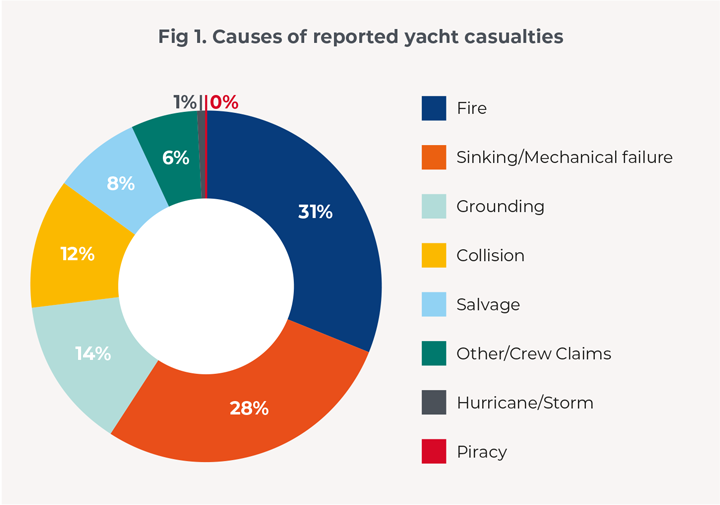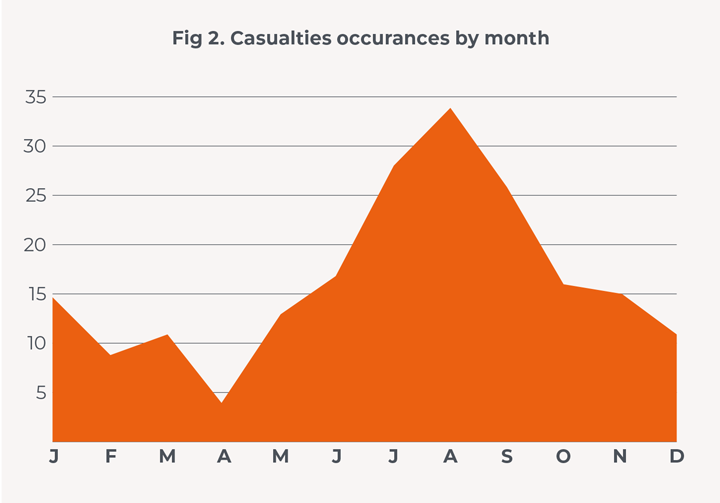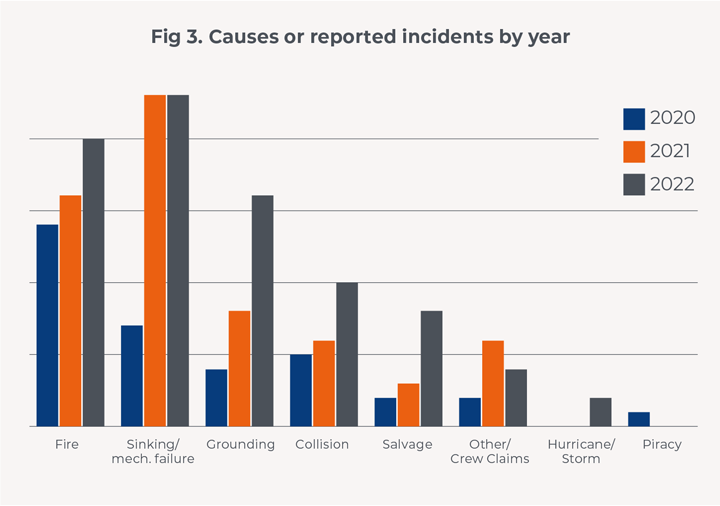Briefings
Comprehensively Yachts - HFW YACHTING INDUSTRY BRIEFING, May 2023
As we enter another Mediterranean yacht season, with yachts and crews engaging in last minute tweaks before owners and guests start their first cruises of the year, we are pleased to bring you a bumper edition of Comprehensively Yachts.
In keeping with our commitment to include discussion of at least one environmental matter or initiative in each edition, we begin with a look at yachting’s role in the development of future sustainable technology and some of the support available to owners and managers in their journey to more sustainable yachting.
With the extended detention by the UK authorities of motor yacht PHI once again back in the news, our sanctions experts consider briefly the latest developments in that case.
A yacht is nothing without its crew and a happy crew can only be beneficial for owner and charter guests alike. Our employment colleagues consider whether the yachting industry is doing enough, and the steps that can be taken to ensure a positive working environment on board and to reduce the risk of negative incidents and the potential legal liability that goes with them.
Next our British Virgin Islands team review the impact of the recent blacklisting of the British Virgin Islands by the EU Council and how things may develop from here.
With a growing list of yacht casualties, we finish with a detailed analysis from our admiralty and crisis management colleagues of recent yacht casualty trends and some suggestions for how the risk of a serious incident or even a total loss might be mitigated.
If you have any questions on any of the content, or suggestions for other topics you would like to see covered in the next edition, please contact a member of the HFW yacht team.
William MacLachlan
Editor
Leading the Way!
Attendees of the final day of the November 2022 edition of the Superyacht Forum in Amsterdam were given cause for reflection when members of the Extinction Rebellion Group staged a protest targeted against the very existence of the superyacht industry. The activists were promptly invited on stage to share their point of view with conference participants, which opportunity they used to make clear that the eyes of the public are fixed firmly on the industry, and to argue that its social licence to operate is being challenged. The same activists also attempted to break into the Superyacht Investor Conference, and though no stage was given to them, their message was still loud and clear.
Many in the yachting industry would argue that this criticism is not entirely justified. Just as new technology in the motoring sector is so often developed for the luxury end of the market before filtering down to more mainstream vehicles, yachting is often an incubator for technological developments which are ultimately adopted by the broader maritime sector. There have always been yacht owners willing and financially able to invest in the cutting edge of yacht construction, naval architecture, design and project management and, in this day and age, these efforts are as often focussed on developing more sustainable forms of propulsion as they are on performance and comfort.
There are multiple examples of innovative designs which might challenge the apparent public view, ranging from the fossil fuel free sailing, through the battery technology being developed, to power yachts and the use of hydrogen fuel cells. None of these projects would be possible without both the industry and yacht owners being prepared to fund the necessary research and development costs.
Whilst yachting so often provides the inspiration, commercial shipping companies and others are also experimenting with a range of renewable technologies, including the use of sails. Well known among those providing innovative solutions to the commercial world are Windship Technologies, who have developed an auxiliary power system designed to convert large commercial ships into hybrid vessels with the potential to cut fuel costs by up to 80%. It will be interesting to see whether motor yachts in turn adopt and further develop this technology.
A number of yacht managers offer programmes designed to help improve the environmental efficiency of operational and new build yachts and several, including Döhle Yachts (whose Environmentally Efficient Yachting “EEY” product was launched some time ago), are actively encouraging their clients to take steps to reduce their yacht’s impact on the environment and providing them with the tools to do so.
In a timely response to Extinction Rebellion’s Amsterdam protest, Dutch public benefit organisation the Water Revolution Foundation launched their Yacht Environmental Transparency Index ( YETI)1 the following day at METSTRADE. The Water Revolution Foundation, founded in 2018, is one of a growing number of initiatives aiming to harness the yachting industry’s potential for sustainable development and encourage its growth.
The YETI project developed from the observation that large yachts, unlike commercial ships, have no natural end of life (if appropriately retrofitted with new technologies and equipment) and the desire to create a benchmark by which the environmental credentials of existing yachts can be measured and, over time, improved. A yacht’s YETI score, once calculated, is not the end-goal but is intended to be a guideline, a catalyst for change, and a decision support system. For example, when making choices about refit or upgrade, a yacht’s owner and management team may be guided by the impact of potential solutions on the yacht’s YETI score, and make the decisions which result in a demonstrably reduced ecological footprint.
The YETI tool calculates a yacht’s total emissions by analysing inputs including propulsive power demand and hotel electric load. The output (expressed in EcoPoints) is then divided by the yacht’s gross tonnage, and a score is assigned to the yacht within the defined gross tonnage (GT) classes of (i) less than 500GT, (ii) 500 to 3,000GT and (iii) 3,000GT and over. This gives a measure of a yacht’s absolute environmental impact and its relative environmental impact when compared with the rest of the YETI fleet. The emissions calculation goes beyond the yacht itself to factor in external elements such as a shore power study, which takes into account the marinas most visited by the yacht, the behaviour of the yacht when plugged in, and the energy mix of the grids in the countries where such marinas are located.
The industry appetite for YETI 1.0 is understood to be large and 70 yachts are already counted amongst the YETI fleet. The Water Revolution Foundation team are now working towards version 2.0, expected sometime this year, and encourage the participation of new yachts with the assurance that strict confidentiality will be maintained. Shipyard participants at the presentation remarked that the YETI project had proved to be beneficial for business, leading to an increase in data being gathered on a continuous basis from existing yachts, which in turn is contributing to better knowledge and understanding of how yachts are being used and operated.
The launch of YETI 1.0 draws parallels with the 2020 inauguration of the Superyacht Eco Association ( SEA) Index by the Yacht Club de Monaco and Crédit Suisse.2 Both have been created by established industry players in order to provide a metric for measuring the environmental impact of yacht design and use. Both aim to be an impetus to encourage development, innovation and choices which minimise environmental impact and encourage sustainability. In our view, they demonstrate the industry’s commitment to and engagement with sustainability concerns and provide a practical means of demonstrating improvements in the yachting industry’s environmental impact. We look forward to seeing how they develop.
Ultimately, and contrary to popular perception, yachting has always had a great story to tell about its role in the development of technology essential for the future of maritime transport. Where this story goes from here depends on whether yacht owners continue to be willing to invest their own capital in adopting more environmentally sustainable technology and further supporting the next generation of innovators.
Rosina Dyke
Associate, Paris
Ian Hughes
Partner, London
The detention of PHI
The continued detention of the motor yacht PHI by the UK authorities highlights the extent to which sanctions against Russia are still raising new and novel issues for the yachting industry.
All eyes will be on the High Court of Justice in London later this summer when it determines whether to grant an order setting aside the decision to detain PHI. The yacht was initially detained on 28 March 2022 pursuant to UK sanctions against Russia on the ground that it was owned, controlled or operated by a person connected with Russia. That decision was reviewed on 11 April 2022 and, again, on 3 January 2023. On each occasion the detention was maintained.
At a hearing scheduled for July 2023, the High Court will determine whether the decisions of 28 March, 11 April 2022 and 3 January 2023 were lawful and, if not, whether they should be set aside. The case will also raise issues under the Human Rights Act 1998 and in the tort of conversion.
The circumstances which underpin the case are a useful demonstration of the range of powers which have been granted to different government agencies in response to Russia’s invasion of Ukraine, as well as the complexity of the various sanctions measures. In addition to their impact on the yachts themselves and their owners, these measures, of course, continue to impact a range of service providers, including crew, managers, surveyors, suppliers and shipyards, etc. We will be providing a further update on the case once the decision has been handed down as part of our continued work guiding the industry on identifying and managing sanctions risk.
More broadly, the case raises interesting questions about the need to ensure that sanctions are effective, whilst also building in checks and balances to ensure that there is proper oversight of government agencies and it is noteworthy that, by the time the case is heard, the vessel will have been detained (but not seized or frozen) for more than a year.
Daniel Martin
Partner, London
Below Deck the Tide is Turning on Toxic On Board Cultures
Many in the industry are avid viewers of ‘Below Deck’, the popular reality television series chronicling the lives of crew members working and living on board a busy charter yacht. Like it or hate it, most are aware of Below Deck and the antics displayed in it, but where is the line between fiction and reality when it comes to sexual harassment, bullying and discrimination on board?
The 2018 Professional Yachting Industry survey 3 run by the International Seafarers Welfare Assistance Network (ISWAN) found that 65% of participants had witnessed or been aware of an incident of sexual harassment on board, 40% had been the recipient of unwanted physical contact whilst working on board, 50% had been the recipient of unwanted sexual or sexist comments on board, and 65% said that their yacht didn’t have a written policy regarding sexual harassment or that they were not aware of any such policy, if it did exist.
It is the position of the ISWAN that sexual harassment is not being taken seriously by a significant part of the yachting industry and that the industry needs to develop realistic policies and procedures to address sexual harassment and all other forms of bullying and harassment.
Whilst not always applicable in the context of yachting, the Maritime Labour Convention 2006 ( MLC) provides for the fundamental right to the elimination of discrimination in respect of employment and there is no good reason to discount this, even if the MLC does not apply to your yacht. Harassment and bullying on board can have serious consequences for the physical and mental health and well-being of seafarers and can lead to decreased motivation and productivity, increased absenteeism and can compromise cohesive and effective teamwork and ultimately safety.
Yacht crew cannot easily escape a toxic, discriminatory, bullying or harassing workplace environment as the yacht is their home. On a yacht the boundaries between work, home and private life are blurred and thus the impact of such an environment can be compounded.
It is a small working environment, crew are isolated from their family, friends and support networks, and their cabins are in close proximity to each other. Whilst less common than it once was, it is still not unheard of for male and female crew members to share cabins.
Dealing with discrimination, bullying and harassment allegations and claims is time-consuming and expensive. In addition, the potential for reputational harm both for the yacht, the yacht’s owner, its captain and its management company is real if the issue is not taken seriously and such allegations and complaints are not handled properly. For the victims and indeed the accused, there can also be huge personal cost in terms of adverse effect on mental health and wellbeing. Thankfully, the tide is now turning and a growing number of yacht owners, captains and management companies are taking the matter seriously.
From the point of view of English law (and any employment tribunals founded in England) this is particularly important because the Worker Protection (Amendment of Equality Act 2010) Bill 4 is currently going through UK Parliament and is likely to come into force next year. If passed, it will result in two key changes in the area of sexual harassment law.
The first change will be the introduction of a mandatory duty on employers to prevent sexual harassment and to take all reasonable steps to prevent sexual harassment. This is a key change, as currently employers can rely on the “reasonable steps” defence if a claim is brought against them, but this will put a positive duty on employers to take all reasonable steps to prevent sexual harassment from arising in the first place. It also means that the Equality & Human Rights Commission could take enforcement steps against employers that do not comply with this mandatory duty, without employees needing to bring a claim.
The second change is to make employers liable for the harassment of their employees by third parties. This will include charter guests and will oblige employers to take all reasonable steps to prevent third parties from harassing their employees in the first place. The size and nature of the employer and resources available to it, as well as the risk factors which need to be addressed within the employer and the industry sector, will be relevant considerations.
It is clear that all need to have regard to ensuring they are adequately addressing the point, but what practical steps should a yacht and its management take to minimise the risk of discrimination, bullying and harassment on board and quickly and effectively deal with any issue that might arise, thereby preventing a toxic on board culture from developing? Amongst other steps, they might consider:
- Adopting a top-down culture of zero tolerance to harassment, discrimination and bullying on board, led by the Captain and line managers. Embedding a “speak up” culture without fear of reprisals.
- Ensuring comprehensive background screening and reference checks are conducted on all new crew members, including details of any grievances raised against them, disciplinary action taken against them and criminal records checks.
- Ensuring policies are consistent and tie in with each other. Updating anti-harassment, email and internet policies to ensure they expressly cover virtual sexual harassment and cyber bullying. Disciplinary procedures should make clear that bullying, discrimination and/or harassment will constitute a disciplinary offence, potentially justifying summary dismissal for gross misconduct.
- Ensuring on board complaint procedures comply with Regulation 5.1.5 of the MLC (whether or not it applies to the yacht). Providing all crew with a copy of the yacht’s on board complaint procedure and details of a person on board to whom confidential complaints can be made and who will assist them with making a complaint, including attending any meetings with them. Crew members should also be made aware that they have a right to complain directly to the Captain. The procedures should provide for the fair, effective and expeditious handling of seafarer complaints and should prohibit victimisation of a seafarer for filing a complaint.
- Requiring crew members to communicate with each other only on platforms that are subject to the employer’s monitoring procedures. Victims of bullying, harassment or discrimination should be encouraged to take screen shots or photos of inappropriate messages and communications which can be used as evidence in internal investigations, disciplinary procedures and any subsequent litigation. For deterrent effect make it clear that emails and instant messaging conversations on work devices may be preserved and used as evidence.
- Encouraging crew members not to give out personal contact details and to communicate only via work mobile phone numbers and work email addresses, as applicable.
- Drawing the yacht’s anti-harassment policy to the attention of charterers, third party guests and suppliers, and including anti-harassment provisions in the yacht’s terms of conditions of business with third parties (e.g. charters and supply contracts).
- Conducting regular training for crew members at all levels, including during the induction process. Ensuring policies are communicated regularly and appropriately to improve awareness of their effectiveness. Updating policies regularly to take account of legislative changes and best practice guidance.
- Taking steps to remove the stigma and shame which puts victims off reporting. Making it clear that sexual harassment, bullying and discrimination can unfortunately happen to crew members at all levels of seniority, all ages and across all genders and sexual orientations.
- Treating all complaints seriously and handling them promptly. Victims often believe it is their fault. It takes courage to speak up. Delays in dealing with complaints can lead to the victim believing that the employer is not taking their complaint seriously, which means they may seek redress outside their employer by reporting it to the police, flag state, port authority or by going to the media, such that the employer loses control of the situation with all the risk that this entails. Delay can also impact adversely on the victim’s mental health leading them to be signed off work sick.
- Recognising that investigatory grievance and disciplinary procedures are stressful for both parties involved and that the alleged perpetrator is innocent until proven guilty. Providing the alleged perpetrator and victim with access to confidential counselling, i.e. an employee assistance programme.
- Not simply moving the alleged victim to a different job or yacht as a way of resolving a case of harassment or bullying. It is often a junior female who makes the complaint and that could give rise to both gender and age discrimination complaints under English law. It could be considered a further act of victimisation against the crew member for having raised the complaint of harassment or discrimination. Further, if the victim has more than two years’ continuous employment then they could, under English law, bring a constructive unfair dismissal claim on the ground that moving them rather than the perpetrator constitutes a fundamental breach of the implied duty of mutual trust and confidence the employer owes them.
- Training captains, line managers and the Designated Person Ashore on how to spot the warning signs and how to deal with sensitive issues. Warning signs can include increased sickness absence, lack of participation in team meetings or reluctance to work with a particular individual.
- Appointing workplace champions on board and ashore who receive specialist training in the sensitive issues involved in discrimination, bullying and harassment. Be aware that victims may only want to report sexual harassment to someone who is the same gender as them.
- Publicising reporting procedures, which need to be easily accessible and user friendly. Displaying anti-harassment, anti-discrimination and anti-bullying policies in prominent public places on board and ensuring that they are available online. They could be put on an app which is automatically installed on all crew members’ devices and which also includes access to a confidential reporting hotline.
- Stressing that reporting procedures are not just for victims of discrimination, bullying and harassment and that anyone who observes the inappropriate conduct of others is under a duty to report it and will be protected from victimisation. Stressing the importance of captains and line managers intervening when they witness inappropriate conduct, so that a culture of banter, bullying or harassment does not grow inadvertently. The number of reports from bystanders, such as other crew members, is a good way of measuring the practical effectiveness of your reporting procedures.
- Tracking the progress of crew members who report sexual harassment, discrimination and bullying and witnesses in investigations to ensure that they do not suffer victimisation or detrimental treatment.
- Using anonymous staff surveys and exit interviews to monitor patterns of bullying, harassment or discrimination or particular areas of the yacht where harassment, bullying or discrimination is at increased risk of occurrence, and dealing with it swiftly to stamp it out before it becomes pervasive.
- Reviewing any settlement agreements at a senior level to monitor effectively the number of discrimination, harassment and bullying claims. Considering whether confidentiality provisions are required in any settlement agreement. Non-disclosure agreements (so called NDAs) are under increased scrutiny because they deter victims of harassment and discrimination from speaking out. Consider whether they are really necessary.
- Remember that under English law, confidentiality provisions in settlement agreements must have carve-outs for protected disclosures under whistle-blowing legislation, which includes breaches of legal obligations if the public interest element is satisfied, so they may not be effective to prevent employees from raising issues of discrimination, harassment and bullying externally.
- Adopting a Code of Conduct. Crew members should be involved in drafting the Code of Conduct which should be a values-based charter which actively promotes a working environment in which everyone is treated with dignity and respect and understands cultural and religious differences. If crew members buy into the Code of Conduct, they are more likely to act in accordance with it and take positive steps to ensure that others adhere to it too.
With our experienced employment team and wider knowledge of the yachting industry and its employment practices/operational constraints, we are well placed to assist you with any employment related issues.
Michelle Chance
Partner, London
The British Virgin Islands (BVI) added to the EU’s ‘blacklist’ of non-cooperative jurisdictions for tax purposes
We are, on occasion, asked whether the grey or blacklisting of a jurisdiction in which a yacht is flagged and/or its registered owner is incorporated will impact a client’s registration and ownership arrangements. In this article, our BVI team explore the potential impact of the recent blacklisting of the BVI and consider the BVI Government’s response, as well as what the future might hold and the impact of it on BVI companies.
Background
The EU list of non-cooperative jurisdictions for tax purposes (the List) was first adopted on 5 December 2017 by the EU Council. The List is part of the EU’s work to “fight tax evasion and avoidance” and it is “composed of countries which have failed to fulfil their commitments to comply with tax good governance criteria within a specific timeframe, and countries which have refused to do so”5.
The listing criteria includes a number of requirements that jurisdictions must meet in order to be considered cooperative for tax purposes, along with certain thresholds on tax transparency, fair taxation and anti-base erosion profit sharing (so called BEPS) measures. The List is updated twice a year based on the outcome of monitoring measures which assess countries and territories against international tax standards.
The BVI was first added to the List in March 2018 as a “largely compliant” jurisdiction. The list of largely compliant jurisdictions (Annex II, also known as the grey list) includes countries which have committed to address certain deficiencies identified by the EU. In the BVI’s case, these deficiencies relate to the EU Council’s finding that the BVI’s tax regime facilitates offshore structures which attract “profits without real economic activity”, in breach of the EU’s fair taxation criteria. The BVI has been taking steps to improve its compliance with international standards and, for example, has introduced measures in relation to beneficial ownership and economic substance.
However, the Organisation for Economic Co-operation and Development’s ( OECD) Global Forum on transparency and exchange of information for tax purposes (Global Forum) assessed the jurisdiction in November 2022 and rated the BVI as “partially compliant” with the OECD scheme. This rating automatically triggered the BVI being placed on the EU blacklist (Annex I) pursuant to the rules of the EU’s Economic and Financial Affairs Council (ECOFIN)6. On 21 February 2023, the BVI was added to the EU’s blacklist (Annex I) for the first time, following a meeting of ECOFIN7.
The EU blacklisted the BVI because the jurisdiction is not, in the EU’s view, sufficiently compliant with one of the EU’s major benchmarks - the Global Forum Peer Review - which assesses compliance with international standards of transparency and exchange of information on request ( EOIR). EOIR is an important tool used by tax authorities around the world to ensure that taxpayers pay the correct amount of tax. Under the EOIR standard, tax authorities can request information from tax authorities in other jurisdictions, such as accounting records, bank statements and information on the ownership of assets. Implementing the EOIR standard requires each jurisdiction to respond effectively to requests received from exchange partners. The EOIR standard is built around three key requirements:
- ensuring the availability of ownership, accounting and banking information;
- providing access to this information by the tax authorities; and
- timely exchange of information with other interested jurisdictions which have entered into a tax information exchange agreement (TIEA).
Once in place and operating effectively in practice, the EOIR standard provides the foundation for effective international co-operation to tackle global tax evasion.
Potential impact of the blacklisting
EU law has minimal direct application outside the EU and, therefore, the BVI’s inclusion on the EU blacklist is unlikely to bring about any immediate negative consequences for BVI companies, structures involving BVI entities or any vessel registered in the BVI.
That said, doing business in a blacklisted jurisdiction can involve additional hurdles. For example, BVI companies may experience higher barriers when seeking finance (even from non-EU sources), and BVI companies, or transactions involving BVI companies, may be subject to additional administrative burdens (i.e. anti-tax evasion or anti-money laundering checks) when doing business in EU Member States or with parties domiciled there.
However, inclusion on the EU’s blacklist does not involve any direct penalties on the BVI and no sanctions will be imposed by EU member states on the territory as a result of the BVI being included on Annex I.
Backward-looking blacklisting
The BVI’s “partially compliant” rating relates to the period 2016-2020 and, therefore, does not take into account key legal developments in 2022 and 2023, in particular the raft of new legislation which was drafted and enacted by the BVI Government in 2022, and which came into force on 1 January 20238. This includes amendment of the BVI Business Companies Act 2004 (and accompanying Regulations) to ensure that the BVI meets the standards set by the Global Forum (i.e. effective and timely exchange of tax information) and which supports the BVI’s long-term commitment to compliance with international best practice9.
BVI Government’s reaction and next steps
In February 2023, the BVI Government requested a review of the BVI’s “partially compliant” rating on the basis that these legislative developments demonstrate that the territory is seeking to meet the OECD’s requirements10.
The OECD’s Global Forum recognised that exceptional circumstances exist, including the BVI’s recent legislative reforms, and agreed to carry out a supplementary review. The OECD’s further investigations are in progress and, if the BVI regains its former “largely compliant” rating from the OECD, the jurisdiction may be removed from the EU’s blacklist (Annex I) when the EU Council updates the List in October 2023.
Conclusion
The BVI is one of many jurisdictions on the EU’s blacklist. The BVI’s inclusion in Annex I relates to the territory’s historic failure to modernise certain financial and reporting systems in compliance with the EOIR standard. The territory weathered various storms during the relevant review period, including Hurricane Irma which made landfall in the BVI in September 2017 and the global pandemic which saw the jurisdiction close its borders for the majority of 2020. During those squally times the jurisdiction had to prioritise urgent matters. However, following the reopening of borders and a return to ‘business as usual’, the BVI government has rectified the deficiencies identified by the OECD and the EU and there is good reason to expect that the BVI will be removed from the EU blacklist later this year.
Scott Cruickshank
Partner, BVI
James Henson
Senior Associate, BVI
Hugo Costa Liziario
Associate, BVI
Catriona Hunter
Knowledge Counsel, Hong Kong
Fail to prepare, prepare to fail
As we go into the new charter season, we appreciate that the last thing you want to be thinking about is what happens if you or your yacht is involved in a casualty. However, each year there will inevitably be a number of superyacht casualties that we are called to assist with - whether it is to deal with and manage a casualty for an owner or an underwriter or to provide support and advise on managing the claim.
Yacht casualties overview
In order to put some context on the scale of the problem, we have collated and analysed data from a variety of sources including the internet, the Lloyds Salvage Arbitration Branch, Lloyds List Intelligence, cases that HFW have been involved with and figures from the underwriting community. The graph in fig 1 is based on the body of data 11 of casualties12 that we have sourced and shows the causes of casualties between 2019 and 2022 inclusive.

We then carried out a further review of the dates when the casualties were reported for the same period. This is shown in fig 2.

Finally, we looked at the causes of reported incidents by category for the last 3 years (2020, 2021 and 2022) to see if there were any trends (fig 3).

The data shows that:
- 80% of the casualties took place in Europe and the Mediterranean.
- The greatest cause of loss and/or claims are: fire, followed by mechanical failure/sinking and then grounding.
- The number of losses due to fire has been increasing whilst losses due to mechanical failure and/or sinking have remained static.
- The number of groundings, collisions and salvage claims have increased by more than 50% from 2020 to 2022.
- You are more likely to have a casualty between the months of June to October with August being the peak time for incidents.
What appears surprising is the increase in the number of fires on board yachts. Given the advances in technology and materials, it would be reasonable to think that the number of fires should be decreasing. However, with the total number of fires at 31% of the data set, this means there has been an average of at least one significant fire on board a yacht every month!
Lithium-ion battery fires on yachts
One possible answer for the increase in fires may be the increase in use of toys and vehicles on board yachts using lithium-ion battery packs. Two reported incidents published by Transport Malta highlight this exact problem. The fire on board “KANGA” in 2018 13 and “SIEMPRE” in 202114 are both believed to have started by lithium-ion battery packs for the hydrofoil surfboard and electric surfboards on board the yacht.
Many yacht owners also transport luxury cars on board their yachts and this may not be without its own problems. In 2022 the commercial car carrier, the “FELICITY ACE”, sank in the Atlantic with 3,828 cars on board (including 20 Lamborghini Huracans, 15 final edition “Ultimae” Lamborghini Aventadors, 50 Urus SUVs, 1194 Audis including over 100 e-trons, 190 Bentleys, 1117 Porsches including 911’s, Boxsters, Taycans, Cayennes, Panameras and Macans and 523 Volkswagens). Although the origin of the fire is unknown, the cause of the fire is believed to have been in one of the electric vehicles.
Whilst lithium-ion batteries are a great technology allowing for the storage of large amounts of energy in small spaces, and with high energy densities, they presently have numerous safety concerns.
Superyacht owners and operators are undoubtedly familiar with the dangers of fires related to faults in switchboards, main machinery, or as a result of poor housekeeping, etc. However, the increase in fires involving lithium-ion batteries highlights the need for crew familiarisation to ensure that they are able to deal with the complex and catastrophic dangers posed by lithium-ion battery fires.
Lithium-ion battery fires are quite unlike other fires superyacht owners are likely to have encountered before. When a lithium-ion battery fails, the speed of failure (seconds), production of significant quantities of toxic, corrosive and flammable gases (000’s of litres), as well as the rapid development of intense heat (+450ºC) and explosive situations can result in the total loss of the yacht or vessel in under an hour. Once failure starts, it can lead to ‘thermal runaway’ and the fire becomes self-sustaining. At this point, all the experts agree that it is very difficult to stop the fire. This in turn results in battery temperatures rising exponentially and perpetuating the fire.
The crew need to be taught, and practice, particular firefighting techniques. With a lithium-ion battery fire, it is not just smoke that you are breathing in but toxic gas that can be harmful to health. The types of gas produced may include hydrogen fluoride which is both toxic and corrosive. Hydrogen fluoride becomes hydrofluoric acid in water and so any trapped firefighting water within the hull will need to be dealt with appropriately. Any crew entering an area with a battery failure should only do so wearing breathing apparatus and protective equipment.
Lithium-ion battery fires also burn for long periods and can reignite hours, days, or even weeks later. They burn with a sustained flame which makes lithium-ion fires difficult to suppress. A 2022 report by Brookes Bell in conjunction with the TT Club and UKP&I Club 15 found that about 136,000 litres of water over four hours would be needed to extinguish an electric vehicle fire, compared with about 10,000-17,000 litres of water over 30 minutes for a fire involving a car with a normal combustion engine.
Check your insurance
As a result of the increase in fires and casualties caused by lithium-ion batteries, some insurers are now refusing to insure superyachts that make use of, or carry, devices and/or toys that include lithium-ion batteries. Other insurers are asking owners to agree to clauses whereby they are responsible for 50% of any loss due to the misbehaviour of lithium-ion batteries.
As such, it is important to check the extent of the cover that you have available for damage caused by fire. Inevitably, this will depend on the wording of the policy. Most underwriters adopt standard form wordings which will provide some form of cover for damage resulting from fire, but it would be sensible to ask if there is an exception or carve out in the policy for lithium-ion powered craft. For example, the Institute Yacht Clauses (1/11/85) specifically list ‘fire’ as an insured peril. Fire is also included within the ‘all risks’ cover provided in the American Yacht Form R12 insurance wording.
In addition to hull cover, most standard form wordings will also provide for third-party liability or P&I insurance as well although it is usual for P&I to be provided under a separate policy.
Policies commonly include warranties requiring the yacht to be manned “at all times”. If a fire breaks out on board the yacht whilst a lithium-ion battery is charging then this may give the underwriters grounds to pull cover. This will of course depend upon the specific wording of the warranty. To date, the courts have demonstrated a flexible approach to the interpretation of “at all times” warranties which will usually be given their natural and ordinary meaning taking into account the wording of the particular warranty along with its commercial purpose and the practical context.
For example, the warranty “Owner and/or Owner’s experienced skipper on board and in charge at all times and one experienced crew member” was interpreted as being primarily focused on protecting the vessel from navigational hazards and, therefore, did not preclude a claim for loss by fire whilst the crew were onshore with the vessel moored up in port16. However, the warranty “fully crewed at all times” was construed more narrowly and was found to require at least one crew member on board the vessel 24 hours a day save for certain limited exceptions – i.e. not part of a day and/or part time17.
The Insurance Act 2015 (IA2015) changed the landscape in England for insurers’ remedies for breaches of warranties. This means that the courts will interpret a breach of warranty on the specific facts. If an insured is in breach of a warranty, the remedy will depend on the nature of the warranty. Since many yacht insurance policies are governed by English law, the IA2015 is likely to apply regardless of where your superyacht is moored or based.
If the yacht is subject to a fire during a charter then, under the Mediterranean Yacht Brokers Association (MYBA) Charter Agreement terms, provided that the fire was not caused by any act or default of the charterer (for example if he bought his own lithium-ion powered vehicle on board and the battery caused the fire), then the owner would be required to refund the charter fee for the proportion of the charter period outstanding after the date when the loss occurred. The charterer would also be entitled to recover from the owner his or her reasonable expenses for repatriating them and or their guests to the place of re-delivery plus reasonable accommodation expenses incurred.
Some practical considerations
If you or your owner has invested in some new toys for this year’s charter season, it might be worth working through the following checklist to make sure you have mitigated the risks. This list is not exhaustive and is no substitute for proper due diligence and planning but it may help.
- Speak to your broker and/or underwriter to make sure that you have cover in place for the carriage and use of any toy or vehicle (cars, submarines, tenders) that use lithium-ion batteries as their main power source.
- Consider if any improvements need to be made to the yachts’ automatic fire detection alarm systems.
- Buy and stow additional fire blankets to be kept near to where the lithium-ion batteries will be stored and/or charged.
- Get your crew trained and/or send them on shore-based practical training courses for dealing with lithium-ion battery fires.
- Upgrade the personal protective equipment (PPE) on board and drill the crew on its use.
- Consider buying and using hand-held thermal imagery equipment on board and on shore to check for elevated battery temperatures.
- Carry out a full review of the various statutory regulations (e.g. HSE, SOLAS & STCW) and relevant standards to ensure that the yacht complies with best practice.
- Prepare guidance for the crew setting out when and where devices and batteries are charged, ensuring they are on hard surfaces and ideally not charged overnight and left unattended.
- Whenever charging electric toys, try to make sure that this takes place outside of the accommodation area or workplace (e.g. seabobs, bicycles and scooters).
- Ensure that an incident does not affect the ability of the personnel on board to exit and escape any spaces.
- Follow the manufacturers’ recommendations for charging but as a general rule:
- avoid storing or charging at very low or very high temperatures and always allow for ventilation in hot environments
- do not leave batteries charging in direct sunlight
- avoid leaving on a continuous charge when a device is not in use
- never cover batteries, chargers or charging devices whilst they are plugged in and charging
- protect batteries from being mechanically damaged, as far as possible
- Always source branded, genuine battery replacements from reputable suppliers. Copies or generic chargers, charging cables and batteries may invalidate the warranty and, more importantly, may not have been constructed with appropriate safety mechanisms built in.
Further reading
In the UK, the MCA has closed the consultation period on draft MGN681(M) which deals with fire safety and stowage of small electric powered craft on yachts. This should be read alongside the Red Ensign Group Yacht Code – either Part A – up to 12 passengers – or Part B – up to 36 passengers . A copy of draft MGN681(M) can be found here and contains guidance on the following points that may be of further interest:
- The risk of fire using lithium-ion batteries
- Storing and charging lithium-ion batteries
- The use of Battery Maintenance Systems
- Fire detection and alarms
- Fire suppression systems
- Crew training
Tom Walters
Partner, London
Alex Kemp
Partner, London
William MacLachlan
Partner, London
Footnotes
https://waterrevolutionfoundation.org/activities/yacht-environmental-transparency-index/
SEA Index tool - Superyacht Eco Association Monaco (sea-index.com)
ISWAN | The Welfare of Superyacht Crew – Report launched (seafarerswelfare.org)
Worker Protection (Amendment of Equality Act 2010) Bill - Parliamentary Bills - UK Parliament
EU list of non-cooperative jurisdictions for tax purposes - Consilium (europa.eu)
The source data is based on 200 casualties all involving yachts in excess of 20 metres.
The reference to “casualty” means any event that resulted in a claim on the policy – either P&I or H&M – or that resulted in a Commercial Total Loss or Total Loss being paid out.
https://mtipcms.gov.mt/en/msiu/Documents/MY%20Kanga_Final%20Safety%20Investigation%20Report.pdf
https://mtip.gov.mt/en/msiu/Documents/MY%20Siempre_Final%20Safety%20Investigation%20Report.pdf
https://www.brookesbell.com/fileadmin/uploads/brookesbell/Documents/Lithium_batteries_whitepaper.pdf
Pratt v Aigaion Insurance Co. SA (The Resolute) [2008] EWCA Civ 1314
GE Frankona Reinsurance Ltd v CMM Trust No 1400, The Newfoundland Explorer [2006] EWHC 429 (Admin)
Comprehensively Yachts
The HFW yacht team has been an integral part of the yacht industry for over 30 years and has a physical presence in many of the major yachting jurisdictions. The enduring relationships developed with the owners, builders, designers, financiers, insurers, brokers and managers of yachts, our in-depth knowledge of the yacht industry and our international reach ensure we are pre-eminent in the field. For more information on HFW’s yacht team and the services we offer, please see www.hfwyachts.com






















